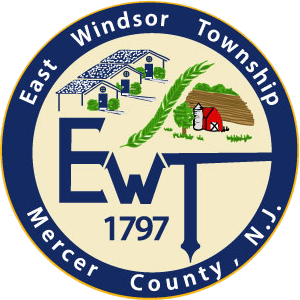Village Nursery
Village Nursery
818 York Road
Black-Locke House
The history of the home and business at this site centers on the Black-Locke family, who have run a nursery here for over 125 years. The first members of the family in East Windsor were brothers Charles (1842-1936) and Joseph H. Black (1844-1930), who came from Middlesex County to work at Isaac Pullen's nursery (see page 25). After Pullen's death in 1867, the Blacks bought the nursery and the house in the photograph above. The photograph on the cover of this book shows the Black brothers posing with their wives in front of the house during this period As the nursery grew, the Blacks gave jobs to their brothers William F. and Elias, finally renaming the nursery "Charles Black and Brothers" in 1876.
The nursery became "Joseph H. Black and Son" when Joseph and Jenny's son Walter C. (1867-1962) bought Charles' share of the business in 1888. Joseph and Walter expanded their land holdings until they owned more than 1600 acres between Cedarville Road arid Hightstown. Joseph used his expertise as a nurseryman to create a number of new varieties of fruit, such as "Joe's Strawberry," which he and Walter advertised in thick, beautifully illustrated catalogues. One of their most popular trees was the "Mercer Cherry" that Joseph created in 1895. Their catalogues described it as the "only sure-bearing, non-rotting Heart Cherry" available. The Blacks used the Pemberton and Hightstown railroad track at the western end of their property to ship their plants and trees to farmers around the country (see page 6).
Joseph and Walter kept busy ont>ng the winter by establishing one of Mercer County' s First Christmas tree farms with Norway spruces imported from Europe They delivered flyers door-to-door throughout the township to advertise their trees, which they delivered in time for Christmas.
After Joseph's death, Walter inherited the house and business, along with Brookwood Farm on the eastern side of York Road. Walter and his wife Sarah F. Shinn later donated much of this farm to the Peddie School for use as a golf course. Throughout his life, Walter was devoted to schools and education. Besides teaching mathematics at Rider College, he also served on the Peddie School board for thirty-eight years and on the East Windsor-Hightstown Board of Education for fifty-four years. The township honored Walter's work in education by naming the school on Stockton Street for him.
When Walter retired from the nursery in 1957, his grandson Joseph B. Locke began running the business and renamed it "Village Nursery." The son of Walter's daughter Elma J. and her husband Harry C. Locke, Joseph had begun working at the nursery after school as a boy; he continued full time when he came home from serving in World War II. Once Joseph took over the property, he and his wife Ruth Crandall began restoring the house next door, which had stood empty for twenty-five years.
Besides running the nursery, Joseph Locke also served as township treasurer, then as a number of the township planning board. Public service is something of a family tradition. Joseph's great-grandfather Joseph Black served as the Mercer County Collector and as a freeholder. Walter C. Black was the East Windsor Tax Collector from 1902 to 1961.
Since the township had no space for a tax collector's office, in 1916 Walter began using the building that now serves as the Village Nursery office (above) for tax collections. He let East Windsor use the building as a polling place, as his grandson Joseph has done.
The Available evidence suggests that this office is the Cedarville School House in which Clara Barton taught (see page 20). The Hightstown Gazette reported that Walter bought the school at public auction for $70.00 on August 31, 1914. A date from the 1880's was recently found written on the southern interior wall of the office; the school was rebuilt after a fire in the 1880's. The size and style of the building certainly resembles the township's one-room schoolhouses (see page 17).
